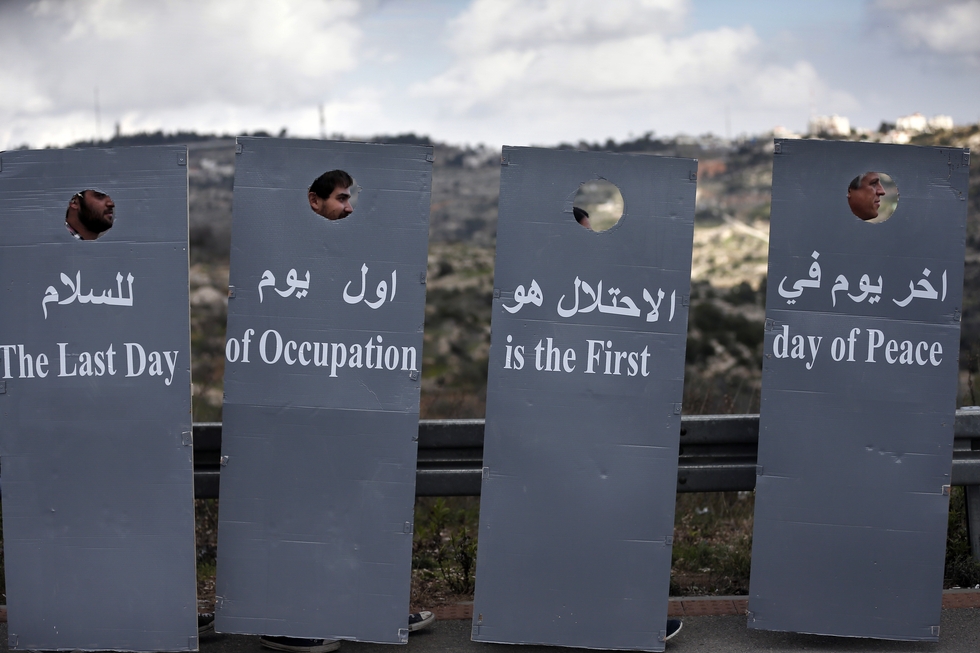Conflating anti-Zionism and anti-Semitism endangers both Palestinians and Jews

Only decades ago, the distinction between anti-Semitism and anti-Zionism was crystal clear. Zionism was a political project for concentrating the Jewish people in the land of Israel, also known as Palestine, and opposition to this project was at least as common inside the Jewish community as it was outside it. Communist and socialist Jews opposed Zionism on the grounds that the problems faced by Jewish workers would be solved through struggle alongside their Gentile brethren.
Orthodox Jews opposed it on theological grounds, arguing that the “Ingathering of the Exiles” could only take place by divine will and that the attempt to undertake it by political and military means constituted a rebellion against God. Jews of all political and religious stripes worried that Zionism would provide anti-Semites with “evidence” for the disloyalty of Jews to their homelands and a pretext for discrimination and deportation.
The conventional wisdom charges that the Zionist approach was vindicated by the Nazi Holocaust. The horrifying extermination of European Jewry supposedly proved to Jews everywhere that they would only be safe in a state of their own. But there is little evidence that Holocaust survivors emerged from the camps as committed Zionists. For most “displaced persons,” the options of returning to their homes in Eastern Europe or emigrating to Western Europe or North America were denied by the rapidly forming Eastern and Western blocs.
The partition of Palestine between a Jewish and an Arab state, a solution adopted by the UN in 1947, afforded the Allies with a convenient solution to the problem of the “displaced persons." But the end of the British Mandate resulted in the creation of a new and intransigent refugee problem – that of the majority of the Palestinian people, expelled from their homes in the resulting war of 1947-9.
In the years following, a similar dynamic operated in the Middle East, whose Jewish communities became the largest demographic reserve for the new state. Israel’s interest in drawing Jewish immigration coincided with that of regimes in countries like Iraq and Egypt in confiscating Jewish property and consolidating their rule on ethno-religious lines.
Upon arrival in Israel, Jews were met by the institutions of an authoritarian state, which instituted an intra-Jewish hierarchy which discriminated against Middle Eastern Jews, today known as Mizrahim, and more generally conditioned the distribution of resources along lines of ideological loyalty, specifically aiming to isolate the only anti-Zionist political force allowed to operate legally, the Communist Party.
In the North American Jewish community, to this day the largest and wealthiest outside Israel, Zionism did not become an unshakeable consensus until Israel became an integral part of the American imperial bloc in the late 1960s.
In the Orthodox world, split in the mid-20th century between religious Zionists and the haredi or ultra-Orthodox movement which rejected Zionism, the achievement of Zionist hegemony was slower and more insidious; to this day most haredi communities in Israel maintain symbolic gestures of rejecting Zionism, but in practice adhere to nationalistic trends – with vocal but tiny exceptions including the Satmer and Neturei Karta groups.
Finally, the breakup of the USSR in the early 1990s and the subsequent exodus of its Jews to Israel, Western Europe and North America signalled the end of the last major Jewish community in which Zionism was not the dominant ideology.
The Zionist movement and its institutions, including the Israeli state itself, have used this newfound hegemony to rewrite history, retroactively “Zionizing” all Jews and equating anti-Zionism with anti-Semitism. This is the thrust behind Prime Minister Netanyahu’s preposterous contention that pre-war Palestinian leader Mufti Haj Amin al-Husseini convinced Hitler to massacre the Jews. It is also at the root of the horror with which Zionists reacted to former London mayor Ken Livingstone’s recent comments about the links between the Nazi party and their movement.
While inaccurate and tactically ill-advised, Livingstone’s comments are based on facts recognised by all experts in the field – which is precisely why they are so intolerable to the Israeli establishment and its allies.
The toleration of Zionist organisations despite the repression of all other Jewish community life in Nazi Germany, the Ha’avara agreement between the Nazis and the Zionist movement, as well as Israel’s absolution of the West German successor state in return for massive financial and military aid – all these are events which were well-known at their time and became huge controversies in the Jewish community in Israel and around the world. In the interest of maintaining Zionist ascendancy over that Jewish community today, these historical truths must be denied at all costs and replaced with a fabricated history that conflates the rejection of Zionism with hatred of Jews as such.
Conflating Zionism and anti-Semitism
So it seems that the non-Zionist Jews of the previous century were right to worry: the conflation of Jewishness with Zionism puts Jews everywhere in danger.
Jews around the world have been metaphorically kidnapped and held as hostages in the Zionist offensive on the Palestinian people. The justified anger of people of conscience, which should rightly be focused on the Israeli state which deprives the Palestinian people of its rights and the imperial powers which support it so generously, is now easily deflected onto ordinary Jews who bear no responsibility for these crimes.
Once this is achieved, nothing is easier than to paint all pro-Palestinian sentiment as anti-Semitic and to mobilise Jewish opinion around the Zionist institutions which purport to stand up for their rights. Conversely, then, nothing is more important for the Palestine solidarity movement then to adamantly defend the distinction between anti-Zionism and anti-Semitism, to educate its activists as to the pre-Zionist and anti-Zionist history of the Jewish people, and to weed out the few truly anti-Semitic provocateurs who infiltrate its ranks. This imperative is realised and acted upon daily by Palestine solidarity activists.
The current furore around the British Labour Party, as others have noted, is not primarily about anti-Semitism; it is part of an attempt by the Blairite right wing and its allies outside the party to bring down Jeremy Corbyn’s progressive leadership by any means necessary. The commitment of these forces to Zionism and Israel is not irrelevant, but more consequential for their goals is the way that Zionism has been able, through its capture of worldwide Jewry, to present an anti-racist movement (anti-Zionism) as a racist one (anti-Semitism).
No more perfect weapon could be sought by those attempting to bring about demoralisation in a movement deeply committed to the struggle against racism, like the one led by Corbyn. As a free added bonus, they receive the hypocritical denunciations of the morally bankrupt Israeli Labour Party, whose leader recently diagnosed his party’s problems as a result of “too much Arab-loving.”
If the results of the recent UK local elections are any indication, the smear campaign against Corbyn and Labour’s left-wing leadership has failed for the time being. The moment can now be seized by progressives, hopefully including Corbyn and his allies, to re-establish the important distinction between anti-Zionism and anti-Semitism.
In developing a nuanced but firm position on Zionism, the resurgent left may find a receptive audience in young Jews in America and Europe, who are increasingly alienated from Israel and the Zionist establishment. One can hardly exaggerate the importance of winning over a sizable proportion of this group in the struggle for a word in which both Palestinians and Jews are safe and free.
- Matan Kaminer is a political activist and a PhD candidate in anthropology at the University of Michigan, doing research on migrant farm workers and their employers in the Arabah region of Israel.
The views expressed in this article belong to the author and do not necessarily reflect the editorial policy of Middle East Eye.
Photo: Israeli and Palestinian peace activists walk behind cardboard cut-outs depicting the Israeli controversial separation barrier as they wave a Palestinian national flag during a peace march at an Israeli road near a checkpoint between the West Bank city of Beit Jala and Jerusalem on 15 January, 2016 (AFP).
New MEE newsletter: Jerusalem Dispatch
Sign up to get the latest insights and analysis on Israel-Palestine, alongside Turkey Unpacked and other MEE newsletters
Middle East Eye delivers independent and unrivalled coverage and analysis of the Middle East, North Africa and beyond. To learn more about republishing this content and the associated fees, please fill out this form. More about MEE can be found here.





